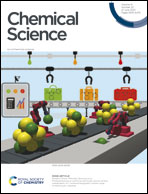Unveiling catalyst-free electro-photochemical reactivity of aryl diazoesters and facile synthesis of oxazoles, imide-fused pyrroles and tetrahydro-epoxy-pyridines via carbene radical anions†
Abstract
Herein, we report a reagent-less (devoid of catalyst, supporting electrolyte, oxidant and reductant) electro-photochemical (EPC) reaction [electricity (50 μA) and blue LED (5 W)] of aryl diazoesters to generate radical anions which are subsequently reacted with acetonitrile or propionitrile and maleimides to generate diversely substituted oxazoles, diastereo-selective imide-fused pyrroles and tetrahydroepoxy-pyridines in good to excellent yield. Thorough mechanistic investigation including a ‘biphasic e-cell’ experiment supports the reaction mechanism involving a carbene radical anion. The tetrahydroepoxy-pyridines could be fluently converted to fused pyridines resembling vitamin B6 derivatives. The source of the electric current in the EPC reaction could be a simple cell phone charger. The reaction was efficiently scaled up to the gram level. Crystal structure, 1D, 2D NMRs and HRMS data confirmed the product structures. This report demonstrates a unique generation of radical anions via electro-photochemistry and their direct applications in the synthesis of important heterocycles.

- This article is part of the themed collection: 2023 Chemical Science Covers


 Please wait while we load your content...
Please wait while we load your content...